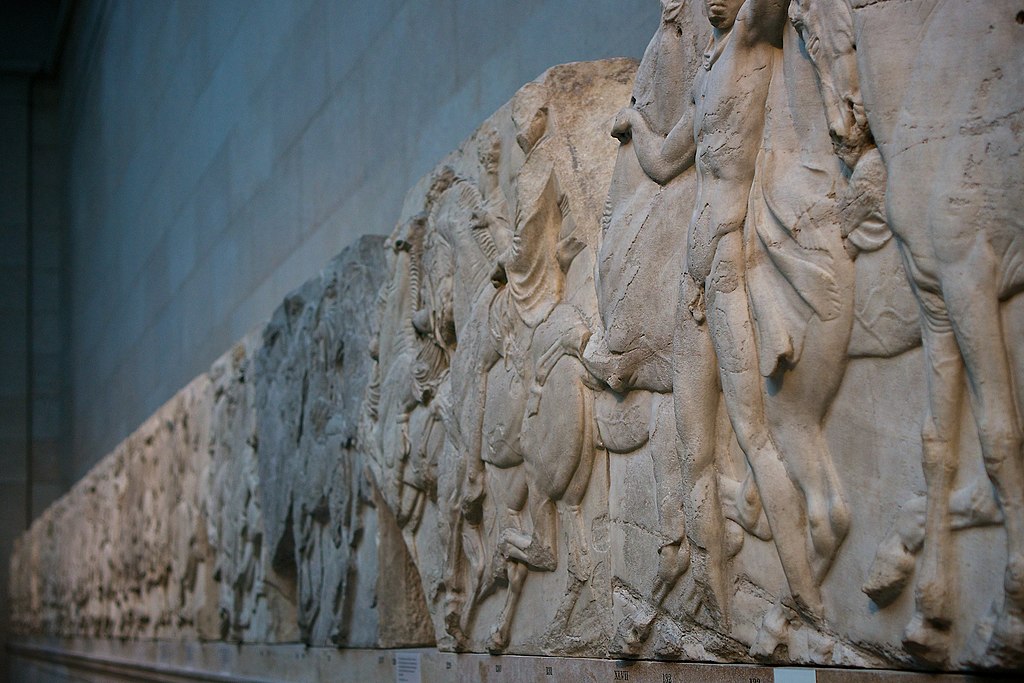The Parthenon Marble is a 160-meter-long by one-meter-wide marble frieze depicting the procession during the great Panathenaeas. The Panathenaea (or Panathenaia) was a multi-day ancient Greek festival held annually in Athens to celebrate the goddess Athena. The frieze, carved between 442 and 438 BC, initially surrounded the inner part of the Parthenon in Athens. In 1801, the British ambassador in Constantinople, Lord Elgin, obtained a permit from the Ottoman government, who at the time ruled Greece, allowing him to take any sculpture he wished from the monuments in Athens. This allowance from the government resulted in 60% of the Parthenon frieze being removed and transported to England. In 1816, the British government purchased the frieze to exhibit in the British Museum in London.
After Greece gained independence in 1821, the newly designated King, Othon I, actively pursued to restore Greece to its ancient glory. Between 1834 and 1843, in alignment with those efforts, he unsuccessfully tried to buy back the Marble of the Panathenaeum from the British Museum. Later, in 1992, the Greek state officially asked the United Kingdom to return the Parthenon frieze but was again met with failure. For a long time, the British Museum used the logic of preservation to justify their possession of the friezes, claiming Greece did not have the resources to accommodate such antiquities. In response, Athens inaugurated the new Acropolis Museum in 2009, specifically designed to house the Parthenon friezes. The museum currently exhibits some original pieces along with replicas of the British Museum’s works as they await the hoped-for return of the fragments held by the United Kingdom.
This ongoing conflict over dual possession has continued to be an issue between Greece and the United Kingdom. In 2019 the issue returned to the forefront when the newly elected Greek Prime Minister, Kyriakos Mitsotakis, asked the UK to loan Athens the frieze to celebrate the 200th anniversary of Greece’s Independence in 2021. The UK agreed to loan the frieze on the condition that Greece recognizes that the Marbles were the property of the British Museum. Athens found this condition unacceptable and subsequently rejected the UK’s request. This request revived the conflict of ownership, leading Greece to demand the return of the Marble once again. In October 2021, the duel took a new turn with UNESCO’s involvement as the organization officially asked the United Kingdom to return the friezes to Greece. As the official spokesman for Athens, PM Mitsotakis feverishly supported the international institution’s request. Mitsotakis claims “the Marbles had been stolen in the nineteenth century” and “belonged to the museum of the Acropolis.” However, British authorities continuously fought back, positing that the sculptures were legally acquired. Today, the two countries cooperate closely under the facilitation of the EU and NATO as well as at the bilateral level, with regular exchanges of high-level official visits and consultations. Realistically, however, it is likely that this cooperation will have difficulty persisting at the cultural and artistic level. Unfortunately for Greece and the United Kingdom, it is challenging to prove either side’s arguments, as they made the transaction before the establishment of international laws regarding property rights.
The return of ”stolen” heritage is not just about aesthetics and paintings. Returning a work of art or artistic legacy demonstrates recognition of a country’s autonomy, identity, modernity, development, and willingness to move forward. Therefore, it implies an acknowledgment of guilt from the UK.
Since the UK acquired many of these items when international property law did not exist, it is difficult to prove that the transaction was illegal and should be considered theft. If the UK recognizes this transaction as illegitimate, it will set a precedent on how the UK absolves conflicts relating to the colonized property. Formerly British-colonized countries claiming the restitution of their displaced cultural heritage would expect the UK to do the same with every other heritage dispute. The return of artwork presents a stake of recognition, reconciliation, and willingness to move beyond the past. This is not only a cultural issue but a major diplomatic one.
The fight between the United Kingdom and Greece over the Parthenon Marbles goes beyond the cultural stakes. With UNESCO’s intervention, it represents a severe diplomatic conflict involving national identity and property rights, which are the most debated aspects of this dual conflict. The recent revival of the conflict on a diplomatic level, combined with the discussions taking place, is adding new pressure on the United Kingdom. When the UK acquired those pieces, Greece was merely a province of the Ottoman Empire. If they were acquired legally, is Greece valid in requesting the return of the art? Therefore, the real question is in proving the nature of the transaction more than debating whether the UK should give the Marbles back. This issue highlights the complexity of possession conflicts regarding cultural heritage, proving that each case is unique and needs to be carefully analyzed.
Edited by Malia Yee

